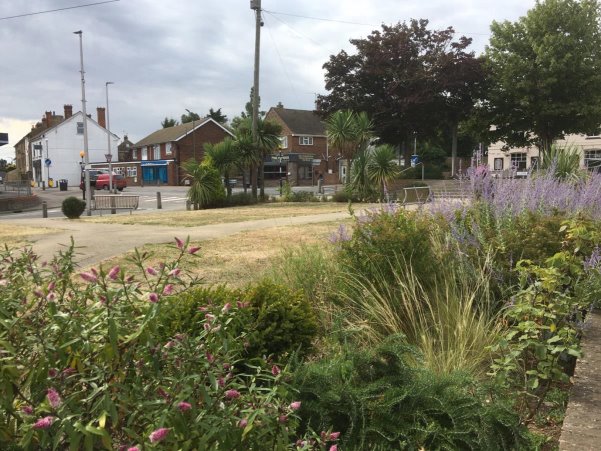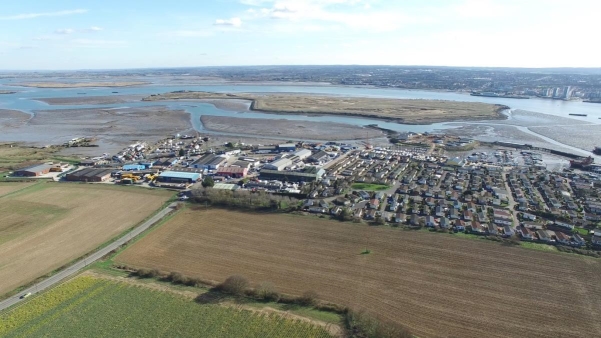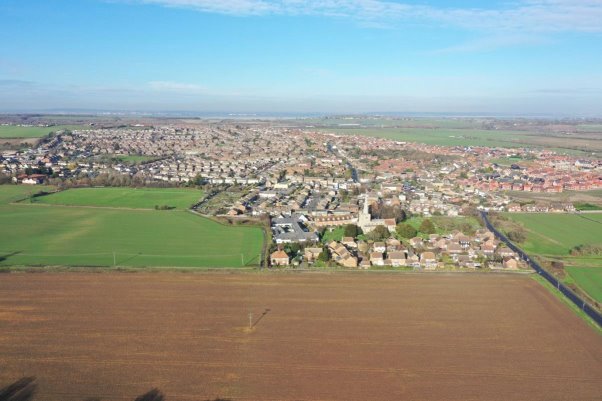Hoo St Werburgh and Chattenden Neighbourhood Plan - Regulation 16
4. Employment and Community Facilities
Purpose
To maintain or expand local employment opportunities and community facilities and to protect and enhance the economic viability of the village centres.
Evidence and Planning Rationale
National Policy
Chapter 6 of the NPPF deals with 'Building a strong, competitive economy' and the need to create conditions for businesses to invest, expand and adapt. This includes consideration of economic and investment strategy, infrastructure, and flexibility to changing practices.
Chapter 8 deals with 'Promoting healthy and safe communities' and states that planning policies should make provision for shared spaces and community facilities and guard against loss of valued facilities and services.
Local Plan
The Medway Local Plan 2003 contains various policies relating to employment, community facilities and former 'A' Use Class matters. These are now somewhat out- of-date due to the age of the plan, changes to national policy and guidance, changes to Use Classes (Class E) and permitted development rights and the impact of COVID. However, many policies are still consistent with the NPPF and have been recognised as such by a number of planning inspectors in appeal cases.
Policy S2 (Strategic Principles) includes reference to a range of community facilities. Policy S12 deals with Kingsnorth industrial sites.
Chapter 4 deals with Economic Development and Chapter 6 deals with Town Centres and Retailing. Chapter 9 deals with Community Facilities. Policies of particular relevance are:
- BNE26: Business Development in Rural Settlements
- R10: Local Centres, Village Shops and Neighbourhood Centres.
- CF1: Community Facilities
- CF2: New Community Facilities
- S14 deals with Chattenden Barracks and recognises the long-term development potential of the site for business, educational or residential uses.
Homes England controls the previously developed sites within the former Ministry of Defence Estate in Chattenden ( the land at Lodge Hill Camp and Chattenden Barracks).
The Neighbourhood Plan seeks to add detail and local focus to these policies.
The emerging Local Plan also deals with economic development, rural economy and high streets, but even these now need to be updated.
Planning Background
Employment opportunities are very limited in the Neighbourhood Area and most people travel outside of the Parish for work. A large proportion of the residents of the Parish work in London.
There are industrial/commercial parks at Kingsnorth and Hoo Marina. Other local opportunities include distribution, fruit picking and packing, local schools, retail, health and leisure. According to the 2011 census, people in the Neighbourhood Area were employed in the following sectors: Farming, industry, local small businesses and retail. The closure of Kingsnorth Power station was a major employment loss.
The community buildings which can be used by local groups and individuals play an important role in dealing with isolation, providing for social interaction and spaces for education, health and leisure activities. There is an active community, and regular events which are held throughout the year. There are also three thriving sailing clubs at Hoo Marina.
Hoo St Werburgh has one 1.5-acre allotment site, made up of 35 plots, accessed from Everest Drive and owned and managed by the Parish Council. There are private facilities for sport and recreation. Also, the Parish Council also owns and manages recreation and burial grounds:
- Kingshill, located off Fourwents Road a 7.71-acre site including a play park, surfaced football and basketball pitches, woodland walks and open space surrounded by treeline;
- Pottery Road, located off Pottery Road, a 5.32-acre site including two separate play areas for older and younger children, enclosed surfaced football and basketball pitches, skate ramps, adult exercise equipment, sheltered seating area and an open space surrounded by treeline;
- Deangate Ridge former golf course and sports facility;
- Prospective Burial Ground, Vicarage Lane.
Local businesses and community facilities include:
- Two supermarkets, a post office, estate agents, hairdressing salons and smaller shops;
- The Church;
- Two petrol stations;
- Three public houses and a range of restaurants and takeaways;
- An optician, dentist and two pharmacies;
- A garden centre;
- Kingsnorth and Hoo Marina industrial/commercial parks;
- Public toilets and car park in Stoke Road (Medway Council);
- the village hall and the community centre, Chattenden;
- Schools and surgeries.
To make more sustainable work/life patterns and also to respond to changes to work/life patterns as a consequence of COVID, it is necessary to maintain and expand local economic opportunities and community facilities. This will help to create walkable neighbourhoods, where facilities are available in walking distance.
Particular care is required where new community facilities make use of open land, to consider their environmental and landscape impacts.

Hoo village centre and village green.
HOO1: Village Centres and Employment
- Employment development (Use Class E) will be supported in the following locations, subject to meeting the later requirements of this policy:
- Within the village centres;
- Brownfield sites;
- Redevelopment or improvement of existing employment sites.
- Support for employment development is subject to the site having adequate and safe access to a highway with sufficient capacity; and
- Support for employment development is subject to there being no significant adverse impact on:
- the amenities of residential properties by reason of visual intrusion, noise, dust, disturbance, vibration, vehicle movements or other impacts;
- the historic environment, meeting the requirements of HOO7;
- the rural character, landscape and natural environment, meeting the requirements of Policy HOO8.
- Within the village centres, Use Class E and F1 activities will be supported, including recreational, cultural and other community facilities.
- Within the village centres, shop fronts must be retained on ground floor frontage units.
Interpretation
The policy cannot and does not seek to restrict permitted development rights relating to high street changes of use.
Use Class E includes retail, cafes and office space, including hotdesking. Use Class F1 would include various community facilities, including meeting space. The local planning authority would need to decide whether conditions were necessary to restrict activities or hours in the interests of protecting amenity.
Design, transport and other requirements for employment development are set out in later policies.
The policy seeks to support employment development in sustainable locations, and also protect and promote the vitality and viability of the village centres. The policy is flexible, allowing the village centres to adapt.
Planning conditions may be a way of ensuring that shopfronts are retained, where changes of use take place.

Hoo Marina Industrial Estate looking towards the River Medway


HOO2: Community Facilities
- New community facilities, including health facilities, will be supported in the existing built settlements or in other sustainable and accessible locations near to housing, subject to meeting the later requirements of this policy.
- Support for community facilities development is subject to:
- The site has access to a highway with sufficient capacity;
- There are good pedestrian and cycle linkages;
- The type and scale of the new community facilities complements any existing provision of similar facilities nearby.
- Support for new community facility development, or improvement and diversification of existing facilities, will be supported, subject to there being no significant adverse impact on:
- the amenities of residential properties by reason of visual intrusion, noise, dust, disturbance, vibration, vehicle movements or other impacts;
- the historic environment, meeting the requirements of HOO7;
- the rural character, landscape and natural environment, meeting the requirements of Policy HOO8.
- Loss of existing community facilities will be supported only where:
- a similar or better facility is being provided within reasonable walking distance; or
- it can be demonstrated that the facility is no longer viable.
Interpretation
The policy enables new community facilities and supports the retention of existing facilities. This includes shops, pubs, health facilities and other community buildings. It also includes outdoor community facilities, such as sports facilities, recreation grounds, allotments and play facilities. Existing facilities include but are not limited to those named on pages 19 and 20.
The policy would also cover new community facilities that make use of open land, providing they were located near to existing built settlements and housing areas. Particular care would be required in considering the impacts of such development, including on the landscape and natural environment, having regard to Policy HOO8.
Design, transport and other requirements for community facility development are set out in later policies.
For any proposed burial ground it is recommended that detailed information be submitted to the Environment Agency at an early stage, including the size, the number of graves and a site-specific investigation of underlying ground conditions.
Planning applications should include sufficient information to demonstrate how the requirements of the policy are met. To demonstrate that a community facility is no longer viable, it would be expected that it be placed on the open market at a realistic price for a period of at least 12 months.
HOO3: Industry and Distribution
- Industrial (B2) and distribution (B8) development will be supported in the following industrial estates:
- Kingsnorth Employment Area;
- Hoo Marina Industrial Estate.
- Support for industrial and distribution development is subject to:
- The site having adequate and safe access to a highway with sufficient capacity; and
- The scheme including planting and/or other measures to limit visual and other environmental impacts;
- Support for industrial and distribution development is subject to there being no significant adverse impact on:
- the amenities of residential properties by reason of visual intrusion, noise, dust, disturbance, vibration, vehicle movements or other impacts;
- the historic environment, meeting the requirements of HOO7;
- the rural character, landscape and natural environment, meeting the requirements of Policy HOO8.
- For distribution uses, development must include adequate supporting facilities, including lorry parking and toilets for drivers.
Interpretation
The policy addresses recognised problems where distribution uses lack adequate facilities for lorry parking and amenities.


Aerial view of Hoo.